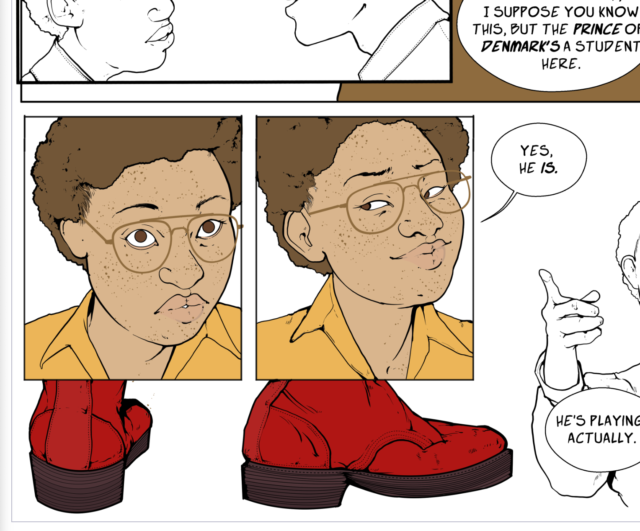My project is a graphic novel called I Am Dead Horatio: an adaptation of Hamlet retold from the point of view of Horatio, the play’s sole survivor. The premise: when Hamlet asks Horatio to “report [him] and [his] cause aright,” what does it mean to tell someone else’s story? Who will tell Horatio’s? Expanding on the play’s themes of grief, remembrance, and biography, IADH is about surviving a Shakespearean tragedy. For this first blog post, I thought I’d start out by covering the purely technical process of creating a graphic novel—or, what I’ll be doing for eight hours a day this summer.
Before working on the project itself, a comics artist usually begins with model sheets, or documents that define the “on-model” look of a character: facial features, bodily proportions, typical outfits. When an artist draws and redraws the same characters again and again, faces have a tendency to incrementally but noticeably drift—cheekbones will rise, noses shrink, or faces narrow. Character sheets are tools for consistency to correct that drift; when a drawing strays too far from a character sheet, it’s called being “off-model.”
Work on an actual graphic novel or comic is usually divided up between at least one illustrator, colorist, and letterist (the one who adds speech bubbles). Since I’m doing all of those jobs, each page of IADH takes five to six hours to draw and color from start to finish. First, I storyboard in a scrap sketchbook; here, I’m experimenting with layout and the basic elements of story flow: how many pages a certain scene will require, or panels per page. Once I’ve finalized the boards, I sketch the first version of the page with pencil on paper—these “pencils” suggest the general poses and expressions of figures, but not much detail. I scan those drawings onto my laptop and import them into Clip Studio Pro, drawing software specifically designed for comics. Here’s a panel with Ophelia:
Using a pen tablet, I trace over them digitally to create a clean, black-and-white line art layer, and add details (things like zippers, fabric creases, stitching, freckles, shoelaces):
Finally, I can color in the line art and add textures:
And that’s the three-step process for every page: “pencilling,” “inking,” and coloring—repeat one hundred times for a 100-page comic. Speech bubbles are added on top afterward, in the comics version of post-production.
As I draw, my goal is to create an adaptation that isn’t just a retelling of its source material but a critical reaction to it—a sort of multidisciplinary research paper, drawn instead of written. In later posts I’ll unpack the comic’s creative rationale, the research behind it, what I’m learning about the process of adaptation, and the surprisingly prolific genre of Shakespeare comic books.
